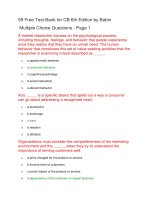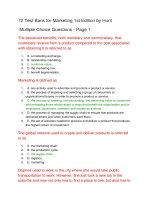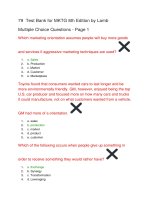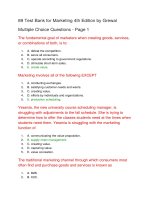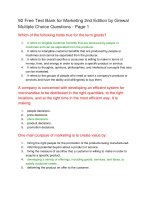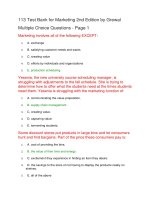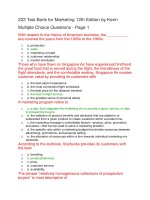Test bank for management 12th edition by daft
Bạn đang xem bản rút gọn của tài liệu. Xem và tải ngay bản đầy đủ của tài liệu tại đây (219.14 KB, 122 trang )
TEST BANK FOR MANAGEMENT 12TH EDITION BY DAFT
1. The nature of management is to control and dictate others in an organization.
aT
.
bF
.
ANSWER:
POINTS:
DIFFICULTY:
REFERENCES:
LEARNING OBJECTIVES:
NATIONAL STANDARDS:
STATE STANDARDS:
KEYWORDS:
OTHER:
2. Recognizing the value of employees involves the organizing role of management.
aT
.
bF
.
ANSWER:
POINTS:
DIFFICULTY:
REFERENCES:
LEARNING OBJECTIVES:
NATIONAL STANDARDS:
STATE STANDARDS:
KEYWORDS:
OTHER:
3. Allocating resources across the organization is part of the organizing management function.
aT
.
bF
.
ANSWER:
POINTS:
DIFFICULTY:
REFERENCES:
LEARNING OBJECTIVES:
NATIONAL STANDARDS:
STATE STANDARDS:
KEYWORDS:
OTHER:
4. How an organization goes about accomplishing a plan is a key part of the management function of controlling.
aT
.
bF
.
ANSWER:
POINTS:
DIFFICULTY:
REFERENCES:
LEARNING OBJECTIVES:
NATIONAL STANDARDS:
STATE STANDARDS:
KEYWORDS:
OTHER:
5. Where the organization wants to be in the future and how to get there defines controlling.
aT
.
bF
.
ANSWER:
POINTS:
DIFFICULTY:
REFERENCES:
LEARNING OBJECTIVES:
NATIONAL STANDARDS:
STATE STANDARDS:
KEYWORDS:
OTHER:
6. The use of influence to motivate employees to achieve the organization's goals refers to controlling.
aT
.
bF
.
ANSWER:
POINTS:
DIFFICULTY:
REFERENCES:
LEARNING OBJECTIVES:
NATIONAL STANDARDS:
STATE STANDARDS:
KEYWORDS:
OTHER:
7. Organizing means defining goals for future organizational performance and deciding on the tasks and resources needed
to attain them.
aT
.
bF
.
ANSWER:
POINTS:
DIFFICULTY:
REFERENCES:
LEARNING OBJECTIVES:
NATIONAL STANDARDS:
STATE STANDARDS:
KEYWORDS:
OTHER:
8. Controlling involves monitoring employee's activities and taking corrective action as necessary.
aT
.
bF
.
ANSWER:
POINTS:
DIFFICULTY:
REFERENCES:
LEARNING OBJECTIVES:
NATIONAL STANDARDS:
STATE STANDARDS:
KEYWORDS:
OTHER:
9. Leading is the use of influence to motivate employees to achieve organizational goals.
aT
.
bF
.
ANSWER:
POINTS:
DIFFICULTY:
REFERENCES:
LEARNING OBJECTIVES:
NATIONAL STANDARDS:
STATE STANDARDS:
KEYWORDS:
OTHER:
10. When an organization is deliberately structured, it is designed to achieve some outcome, such as making a profit.
aT
.
bF
.
ANSWER:
POINTS:
DIFFICULTY:
REFERENCES:
LEARNING OBJECTIVES:
NATIONAL STANDARDS:
STATE STANDARDS:
KEYWORDS:
OTHER:
11. An organization is a social entity that is goal directed and deliberately structured.
aT
.
bF
.
ANSWER:
POINTS:
DIFFICULTY:
REFERENCES:
LEARNING OBJECTIVES:
NATIONAL STANDARDS:
STATE STANDARDS:
KEYWORDS:
OTHER:
12. Efficiency refers to the degree to which the organization achieves a stated objective.
aT
.
bF
.
ANSWER:
POINTS:
DIFFICULTY:
REFERENCES:
LEARNING OBJECTIVES:
NATIONAL STANDARDS:
STATE STANDARDS:
KEYWORDS:
OTHER:
13. All managers have to pay attention to costs and according to research, the best way to improve organizational
effectiveness is by severe cost cutting.
aT
.
bF
.
ANSWER:
POINTS:
DIFFICULTY:
REFERENCES:
LEARNING OBJECTIVES:
NATIONAL STANDARDS:
STATE STANDARDS:
KEYWORDS:
OTHER:
14. The ultimate responsibility of managers is to achieve high performance by balancing efficiency and effectiveness.
aT
.
bF
.
ANSWER:
POINTS:
DIFFICULTY:
REFERENCES:
LEARNING OBJECTIVES:
NATIONAL STANDARDS:
STATE STANDARDS:
KEYWORDS:
OTHER:
15. Efficiency can be calculated as the amount of resources used to produce a product or service.
aT
.
bF
.
ANSWER:
POINTS:
DIFFICULTY:
REFERENCES:
LEARNING OBJECTIVES:
NATIONAL STANDARDS:
STATE STANDARDS:
KEYWORDS:
OTHER:
16. To perform effectively, all managers must possess conceptual, human, and technical skills, though the degree of each
skill necessary at different levels of an organization may vary.
aT
.
bF
.
ANSWER:
POINTS:
DIFFICULTY:
REFERENCES:
LEARNING OBJECTIVES:
NATIONAL STANDARDS:
STATE STANDARDS:
KEYWORDS:
OTHER:
17. Only the top managers in organizations need conceptual skills since it involves planning.
aT
.
bF
.
ANSWER:
POINTS:
DIFFICULTY:
REFERENCES:
LEARNING OBJECTIVES:
NATIONAL STANDARDS:
STATE STANDARDS:
KEYWORDS:
OTHER:
18. A manager's ability to work with and through other people and to work effectively as a group member is called human
skills.
aT
.
bF
.
ANSWER:
POINTS:
DIFFICULTY:
REFERENCES:
LEARNING OBJECTIVES:
NATIONAL STANDARDS:
STATE STANDARDS:
KEYWORDS:
OTHER:
19. Technical skills are most important at lower organizational levels while conceptual skills become more important as
managers move up the organizational hierarchy.
aT
.
bF
.
ANSWER:
POINTS:
DIFFICULTY:
REFERENCES:
LEARNING OBJECTIVES:
NATIONAL STANDARDS:
STATE STANDARDS:
KEYWORDS:
OTHER:
20. One of the biggest mistakes during turbulent times is managers' failure to comprehend and adapt to the rapid pace of
change in the world around them.
aT
.
bF
.
ANSWER:
POINTS:
DIFFICULTY:
REFERENCES:
LEARNING OBJECTIVES:
NATIONAL STANDARDS:
STATE STANDARDS:
KEYWORDS:
OTHER:
21. The ability to motivate others is considered a technical management skill.
aT
.
bF
.
ANSWER:
POINTS:
DIFFICULTY:
REFERENCES:
LEARNING OBJECTIVES:
NATIONAL STANDARDS:
STATE STANDARDS:
KEYWORDS:
OTHER:
22. Managers use conceptual, human, and technical skills to perform the four management functions of planning,
organizing, leading, and controlling in all organizations.
aT
.
bF
.
ANSWER:
POINTS:
DIFFICULTY:
REFERENCES:
LEARNING OBJECTIVES:
NATIONAL STANDARDS:
STATE STANDARDS:
KEYWORDS:
OTHER:
23. Middle managers are responsible for setting organizational goals, defining strategies for achieving them, and making
decisions that affect the entire organization.
aT
.
bF
.
ANSWER:
POINTS:
DIFFICULTY:
REFERENCES:
LEARNING OBJECTIVES:
NATIONAL STANDARDS:
STATE STANDARDS:
KEYWORDS:
OTHER:
24. Facilitating individual employee performance is an important role for top managers.
aT
.
bF
.
ANSWER:
POINTS:
DIFFICULTY:
REFERENCES:
LEARNING OBJECTIVES:
NATIONAL STANDARDS:
STATE STANDARDS:
KEYWORDS:
OTHER:
25. Juan, as a division manager, is generally concerned with the near future and is expected to establish good relationships
with peers around the organization, encourage teamwork, and resolve conflicts. Juan can be described as a middle
manager.
aT
.
bF
.
ANSWER:
POINTS:
DIFFICULTY:
REFERENCES:
LEARNING OBJECTIVES:
NATIONAL STANDARDS:
STATE STANDARDS:
KEYWORDS:
OTHER:
26. A human resource manager would be considered a staff manager.
aT
.
bF
.
ANSWER:
POINTS:
DIFFICULTY:
REFERENCES:
LEARNING OBJECTIVES:
NATIONAL STANDARDS:
STATE STANDARDS:
KEYWORDS:
OTHER:
27. Antonio is head of the advertising department at Terrific Tortillas Inc. He can be described as a general manager.
aT
.
bF
.
ANSWER:
POINTS:
DIFFICULTY:
REFERENCES:
LEARNING OBJECTIVES:
NATIONAL STANDARDS:
STATE STANDARDS:
KEYWORDS:
OTHER:
28. First line managers are the managers who have the responsibility for making the significant strategic policy decisions,
often with staff managers assisting them in these decisions.
aT
.
bF
.
ANSWER:
POINTS:
DIFFICULTY:
REFERENCES:
LEARNING OBJECTIVES:
NATIONAL STANDARDS:
STATE STANDARDS:
KEYWORDS:
OTHER:
29. Staff managers are responsible for the manufacturing and marketing departments that make or sell the products or
services.
aT
.
bF
.
ANSWER:
POINTS:
DIFFICULTY:
REFERENCES:
LEARNING OBJECTIVES:
NATIONAL STANDARDS:
STATE STANDARDS:
KEYWORDS:
OTHER:
30. Manager least enjoy activities such as controlling subordinates and managing time pressures.
aT
.
bF
.
ANSWER:
POINTS:
DIFFICULTY:
REFERENCES:
LEARNING OBJECTIVES:
NATIONAL STANDARDS:
STATE STANDARDS:
KEYWORDS:
OTHER:
31. The individual performer is a generalist and coordinates a broad range of activities.
aT
.
bF
.
ANSWER:
POINTS:
DIFFICULTY:
REFERENCES:
LEARNING OBJECTIVES:
NATIONAL STANDARDS:
STATE STANDARDS:
KEYWORDS:
OTHER:
32. Becoming a successful manager means thinking in terms of building teams and networks, becoming a motivator and
organizer within a highly interdependent system of people and work.
aT
.
bF
.
ANSWER:
POINTS:
DIFFICULTY:
REFERENCES:
LEARNING OBJECTIVES:
NATIONAL STANDARDS:
STATE STANDARDS:
KEYWORDS:
OTHER:
33. Most top executives routinely work at least 12 hours a day and spend 50 percent or more of their time traveling.
aT
.
bF
.
ANSWER:
POINTS:
DIFFICULTY:
REFERENCES:
LEARNING OBJECTIVES:
NATIONAL STANDARDS:
STATE STANDARDS:
KEYWORDS:
OTHER:
34. A manager forwards information to other organization members in the disseminator role.
aT
.
bF
.
ANSWER:
POINTS:
DIFFICULTY:
REFERENCES:
LEARNING OBJECTIVES:
NATIONAL STANDARDS:
STATE STANDARDS:
KEYWORDS:
OTHER:
35. In the spokesperson role, a manager forwards information to other organization members.
aT
.
bF
.
ANSWER:
POINTS:
DIFFICULTY:
REFERENCES:
LEARNING OBJECTIVES:
NATIONAL STANDARDS:
STATE STANDARDS:
KEYWORDS:
OTHER:
36. The informational roles that managers perform include monitor, disseminator, and spokesperson.
aT
.
bF
.
ANSWER:
POINTS:
DIFFICULTY:
REFERENCES:
LEARNING OBJECTIVES:
NATIONAL STANDARDS:
STATE STANDARDS:
KEYWORDS:
OTHER:
37. In the figurehead role, the manager performs ceremonial and symbolic duties.
aT
.
bF
.
ANSWER:
POINTS:
DIFFICULTY:
REFERENCES:
LEARNING OBJECTIVES:
NATIONAL STANDARDS:
STATE STANDARDS:
KEYWORDS:
OTHER:
38. The disturbance handler role involves the initiation of change, thinking about the future and how to get there.
aT
.
bF
.
ANSWER:
POINTS:
DIFFICULTY:
REFERENCES:
LEARNING OBJECTIVES:
NATIONAL STANDARDS:
STATE STANDARDS:
KEYWORDS:
OTHER:
39. In a monitor role, the manager trasmits current information to others, both outside and inside the organization.
aT
.
bF
.
ANSWER:
POINTS:
DIFFICULTY:
REFERENCES:
LEARNING OBJECTIVES:
NATIONAL STANDARDS:
STATE STANDARDS:
KEYWORDS:
OTHER:
40. Managers in small businesses tend to emphasize roles different from those of managers in large corporations.
aT
.
bF
.
ANSWER:
POINTS:
DIFFICULTY:
REFERENCES:
LEARNING OBJECTIVES:
NATIONAL STANDARDS:
STATE STANDARDS:
KEYWORDS:
OTHER:
41. Not-for-profit organizations, such as The Red Cross and the Girl Scouts, represent a major application of management
talent.
aT
.
bF
.
ANSWER:
POINTS:
DIFFICULTY:
REFERENCES:
LEARNING OBJECTIVES:
NATIONAL STANDARDS:
STATE STANDARDS:
KEYWORDS:
OTHER:
42. We might expect managers in nonprofit organizations to place more emphasis on the roles of spokesperson, leader, and
resource allocator.
aT
.
bF
.
ANSWER:
POINTS:
DIFFICULTY:
REFERENCES:
LEARNING OBJECTIVES:
NATIONAL STANDARDS:
STATE STANDARDS:
KEYWORDS:
OTHER:
43. The rise of virtual work has led to a decline in organizational hierarchies.
aT
.
bF
.
ANSWER:
POINTS:
DIFFICULTY:
REFERENCES:
LEARNING OBJECTIVES:
NATIONAL STANDARDS:
STATE STANDARDS:
KEYWORDS:
OTHER:
44. Technological advances have resulted in employees becoming more empowered.
aT
.
bF
.
ANSWER:
POINTS:
DIFFICULTY:
REFERENCES:
LEARNING OBJECTIVES:
NATIONAL STANDARDS:
STATE STANDARDS:
KEYWORDS:
OTHER:
45. Today’s managers rely on “management by keeping tabs” and play the role of a controller instead of an enabler.
aT
.
bF
.
ANSWER:
POINTS:
DIFFICULTY:
REFERENCES:
LEARNING OBJECTIVES:
NATIONAL STANDARDS:
STATE STANDARDS:
KEYWORDS:
OTHER:
Multiple Choice
46. The nature of management is to cope with _____ and far-reaching challenges.
as
.
bp
.
cd
.
do
.
ec
.
ANSWER:
POINTS:
DIFFICULTY:
REFERENCES:
LEARNING OBJECTIVES:
NATIONAL STANDARDS:
STATE STANDARDS:
KEYWORDS:
OTHER:
47. Success in the new workplace depends on the strength and quality of _____.
ai
.
bi
.
cf
.
dc
.
ev
.
ANSWER:
POINTS:
DIFFICULTY:
REFERENCES:
LEARNING OBJECTIVES:
NATIONAL STANDARDS:
STATE STANDARDS:
KEYWORDS:
OTHER:
48. Without _____, no company can survive over the long run.
ac
.
bo
.
c
.
dt
.
ei
.
ANSWER:
POINTS:
DIFFICULTY:
REFERENCES:
LEARNING OBJECTIVES:
NATIONAL STANDARDS:
STATE STANDARDS:
KEYWORDS:
OTHER:
49. Regina, owner and operator of a small restaurant, believes that her most important task as manager is establishing
goals for the restaurant and deciding what must be done to achieve them. This involves which aspect of what managers
do?
aO
.
bM
.
cM
.
dD
.
eS
.
ANSWER:
POINTS:
DIFFICULTY:
REFERENCES:
LEARNING OBJECTIVES:
NATIONAL STANDARDS:
STATE STANDARDS:
KEYWORDS:
OTHER:
50. One of the important ideas in the text's definition of management is:
at
.
bt
.
ce
.
dm
.
e
.
ANSWER:
POINTS:
DIFFICULTY:
REFERENCES:
LEARNING OBJECTIVES:
NATIONAL STANDARDS:
STATE STANDARDS:
KEYWORDS:
OTHER:
51. When senior managers at Gap, Inc. decided to become the number one service-quality clothing company in the world,
they were engaging in the management function of _____.
ap
.
bo
.
cl
.
dc
.
ed
.
ANSWER:
POINTS:
DIFFICULTY:
REFERENCES:
LEARNING OBJECTIVES:
NATIONAL STANDARDS:
STATE STANDARDS:
KEYWORDS:
OTHER:
52. Which of the following is a function of management?
aH
.
bR
.
cE
.
dP
.
eE
.
ANSWER:
POINTS:
DIFFICULTY:
REFERENCES:
LEARNING OBJECTIVES:
NATIONAL STANDARDS:
STATE STANDARDS:
KEYWORDS:
OTHER:
53. Robert, a top-level manager at an advertising agency, spends a significant part of his work day identifying goals for
future organizational performance and deciding how to use resources to attain these goals. This involves which
management function?
aC
.
bL
.
cO
.
dP
.
eD
.
ANSWER:
POINTS:
DIFFICULTY:
REFERENCES:
LEARNING OBJECTIVES:
NATIONAL STANDARDS:
STATE STANDARDS:
KEYWORDS:
OTHER:
54. Selecting goals and ways to attain them refers to _____.
ac
.
bp
.
co
.
ds
.
el
.
ANSWER:
POINTS:
DIFFICULTY:
REFERENCES:
LEARNING OBJECTIVES:
NATIONAL STANDARDS:
STATE STANDARDS:
KEYWORDS:
OTHER:
